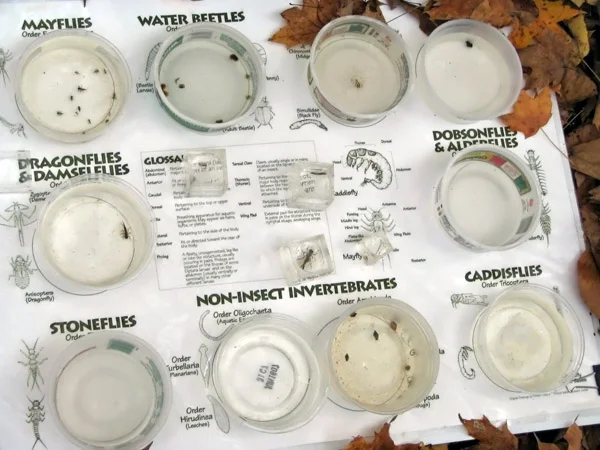Animal Adaptations - Grades 1 -4
Recommended for Grades 1 - 4
Every animal has special features which help it to survive. Together we explore the physical and behavioral attributes of birds, mammals, and insects. Students participate in experiments, view mounted specimens, examine natural history artifacts, and engage in unique activities! (This half-day class may be combined with another, to create a full-day trip to the Conservancy!)
Fee: (includes use of the restroom and picnic facilities when held at the Conservancy)
* $160.00 per class up to 24 students when held at your classroom plus a $10 Travel & Transportation fee per class
* $8.00 per student ($80 minimum per class) when held here at the conservancy
For more information or for reservations contact: PWC Education Department at education@perkiomenwatershed.org
What the students are saying:
“I learned so many new things today! I really liked to touch the animals. I also liked to play the games, it was really fun! I think the watershed is the best place to go in the whole wide world!”
3rd Grade Student, EMC Elementary School
What the teachers are saying:
”Wonderful program - the students were focused the entire time!”
3rd Grade Teacher, Grasse Elementary School
NEW PA STEELS Standareds covered in this lesson inlcude:
3.1.4.A Construct an argument that plants and animals have internal and external structures that function to support survival, growth, behavior, and reproduction.
3.1.1.B Read texts and use media to determine patterns in behavior of parents and offspring that help offspring survive.
3.1.3.A Develop models to describe that organisms have unique and diverse life cycles but all have in common birth, growth, reproduction, and death.
3.1.4.B Use a model to describe that animals receive different types of information through their senses, process the information in their brain, and respond to the information in different ways.
3.1.2.B Develop a simple model that mimics the function of an animal in dispersing seeds or pollinating plants.
3.1.3.B Construct an argument that some animals form groups that help members survive
3.1.1.C Make observations to construct an evidencebased account that young plants and animals are like, but not exactly like, their parents.
3.1.3.C Analyze and interpret data to provide evidence that plants and animals have traits inherited from parents and that variation of these traits exists in a group of similar organisms.
3.1.3.D Use evidence to support the explanation that traits can be influenced by the environment.
3.1.3.F Use evidence to construct an explanation for how the variations in characteristics among individuals of the same species may provide advantages in surviving, finding mates, and reproducing.
3.1.3.G Construct an argument with evidence that in a particular habitat some organisms can survive well, some survive less well, and some cannot survive at all.
3.1.2.C Make observations of plants and animals to compare the diversity of life in different habitats.
3.1.3.H Make a claim supported by evidence about the merit of a solution to a problem caused when the environment changes and the types of plants and animals that live there may change.
PDE Academic Standards covered by this lesson include:
3.1.1.A1 - Categorize living and nonliving things by external characteristics.
3.1.1.A9 - • Distinguish between scientific fact and opinion. • Ask questions about objects, organisms, and events. • Understand that all scientific investigations involve asking and answering questions and comparing the answer with what is already known. • Plan and conduct a simple investigation and understand that different questions require different kinds of investigations. • Use simple equipment (tools and other technologies) to gather data and understand that this allows scientists to collect more information than relying only on their senses to gather information. • Use data/evidence to construct explanations and understand that scientists develop explanations based on their evidence and compare them with their current scientific knowledge. • Communicate procedures and explanations giving priority to evidence and understanding that scientists make their results public, describe their investigations so they can be reproduced, and review and ask questions about the work of other scientists.
4.1.1.A - Identify and describe the basic needs of living things in a terrestrial habitat.
3.1.2.C2 - Explain that living things can only survive if their needs are being met.
4.1.2.D - Identify differences in living things (color, shape, size, etc.) and describe how adaptations are important for survival.
4.1.2.E - Identify how living things survive changes in their environment.
4.1.2.F - • Distinguish between scientific fact and opinion. • Ask questions about objects, organisms and events. • Understand that all scientific investigations involve asking and answering questions and comparing the answer with what is already known. • Plan and conduct a simple investigation and understand that different questions require different kinds of investigations. • Use simple equipment (tools and other technologies) to gather data and understand that this allows scientists to collect more information than relying only on their senses to gather information. • Use data/evidence to construct explanations and understand that scientists develop explanations based on their evidence and compare them with their current scientific knowledge. • Communicate procedures and explanations giving priority to evidence and understanding that scientists make their results public, describe their investigations so they can be reproduced and review and ask questions about the work of other scientists.
3.1.3.A1 - Describe characteristics of living things that help to identify and classify them.
3.1.3.C1 - Recognize that many plants and animals can survive harsh environments because of seasonal behaviors (e.g. hibernation, migration, trees shedding leaves).
3.1.3.C2 - Describe animal characteristics that are necessary for survival.
4.1.3.D - Identify organisms that are dependent on one another in a given ecosystem.
3.1.4.A1 - Classify plants and animals according to the physical characteristics that they share.
3.1.4.A2 - Describe the different resources that plants and animals need to live.
3.1.4.B2 - Recognize that reproduction is necessary for the continuation of life.
3.1.4.B5 - PATTERNS - Identify observable patterns in the physical characteristics of plants or groups of animals.
3.1.4.C2 - Describe plant and animal adaptations that are important to survival.
4.1.4.D - Explain how specific adaptations can help organisms survive in their environment.







